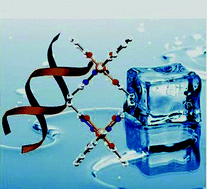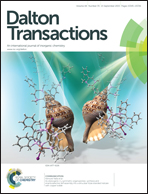A family of Fe3+ based double-stranded helicates showing a magnetocaloric effect, and Rhodamine B dye and DNA binding activities†
Abstract
Herein, the synthesis, structural characterization, magnetic properties and guest binding activities of four Fe3+ based double-stranded helicates namely; [Fe2(L)2](ClO4)(Cl)·4(CH3OH)·2(H2O) (1), [Fe2(L)2](BF4)2·2(H2O) (2), [Fe2(L)2](NO3)2·3(CH3OH)·2(H2O) (3), and [Fe2(L)2](Cl)2·2(CH3OH)·4(H2O) (4) are reported. Complexes 1–4 have been synthesized using the hydrazide-based ligand H2L (H2L = N′1,N′4-bis(2-hydroxybenzylidene)succinohydrazide) and the corresponding Fe2+ salts. Each of the independent cationic complexes [Fe2(L)2]2+ shows double-stranded helicates from the self-assembly of the ligand and metal ions in a 2 : 2 ratio, where the individual Fe3+ centre is lying on a C2-axis and the ligand strands wrap around it. In 1–4, ligand L adopts “pseudo-C” conformations and forms a double-stranded dinuclear helicate with a small cage in between them. Moreover, in 1–4, each of the independent cationic complexes [Fe2L2]2+ is inherently chiral and possesses P for right-hand and M for left-hand helicity and as a consequence is a racemic solid. Detailed magnetic studies of all the complexes reveal that the Fe3+ centres are magnetically isolated and isotropic in nature. Estimation of the Magnetocaloric Effect (MCE) from magnetization data unveils a moderate MCE at a temperature of 3 K with magnetic entropy changes (−ΔSm) of 22.9, 27.7, 24.1, 26.5 J kg−1 K−1 at a magnetic field of 7 T for complexes 1–4, respectively. Also, the variation of the −ΔSm values was justified by considering the parameter of magnetization per unit mass. Stability of all the complexes in solution phase was confirmed by ESI-mass spectrometric analysis and liquid phase FT-IR spectroscopy. Further, the interaction of the complexes 1–4 with Rhodamine B dye was examined by UV-vis and fluorescence spectroscopic study. The observed blue-shift in the fluorescence study and hyperchromicity and hypochromicity with the appearance of two isosbestic points in the UV-vis study ascertain the interactions of the dye with the complexes. A DNA binding study by absorption spectral titration suggests the weak external intercalation of complex 1 within the nucleotide of calf thymus DNA. Computational study supports the isotropic nature of the metal centres and the consequent high spin multiplicity, which assists the complexes to show significant magnetic entropy changes.


 Please wait while we load your content...
Please wait while we load your content...